Gender Inequality: Women and Workplace Discrimination in Australia
VerifiedAdded on 2023/06/13
|6
|1008
|160
Report
AI Summary
This research report delves into the issue of women and workplace discrimination in Australian organizations, highlighting the gender-separated nature of the workforce and the underrepresentation of women in leadership roles and high-paying industries. It addresses the problem of unequal superannuation averages leading to financial challenges in retirement for women. The research aims to investigate the extent of workplace discrimination, explore the reasons behind these issues, and propose solutions to overcome barriers to gender equality. Employing a mixed-methods approach, the study utilizes both qualitative and quantitative data gathered from secondary sources such as government data, academic journals, and online resources. The data analysis includes correlation analysis to identify relationships between variables like workplace safety, flexibility, and demographic factors. The report also references relevant legislation such as the Sex Discrimination Act, emphasizing Australia's commitment to international human rights obligations. This assignment is available on Desklib.
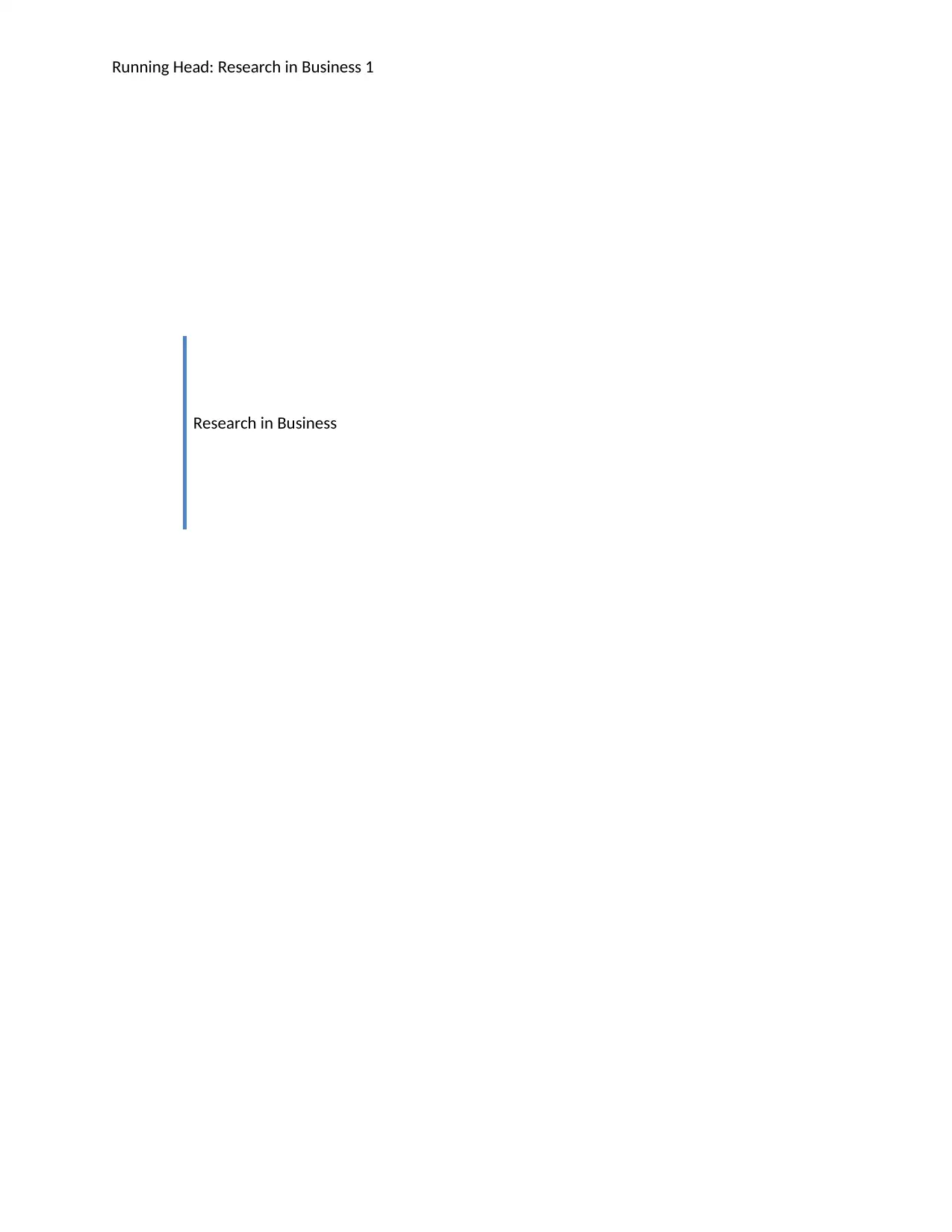
Running Head: Research in Business 1
Research in Business
Research in Business
Paraphrase This Document
Need a fresh take? Get an instant paraphrase of this document with our AI Paraphraser
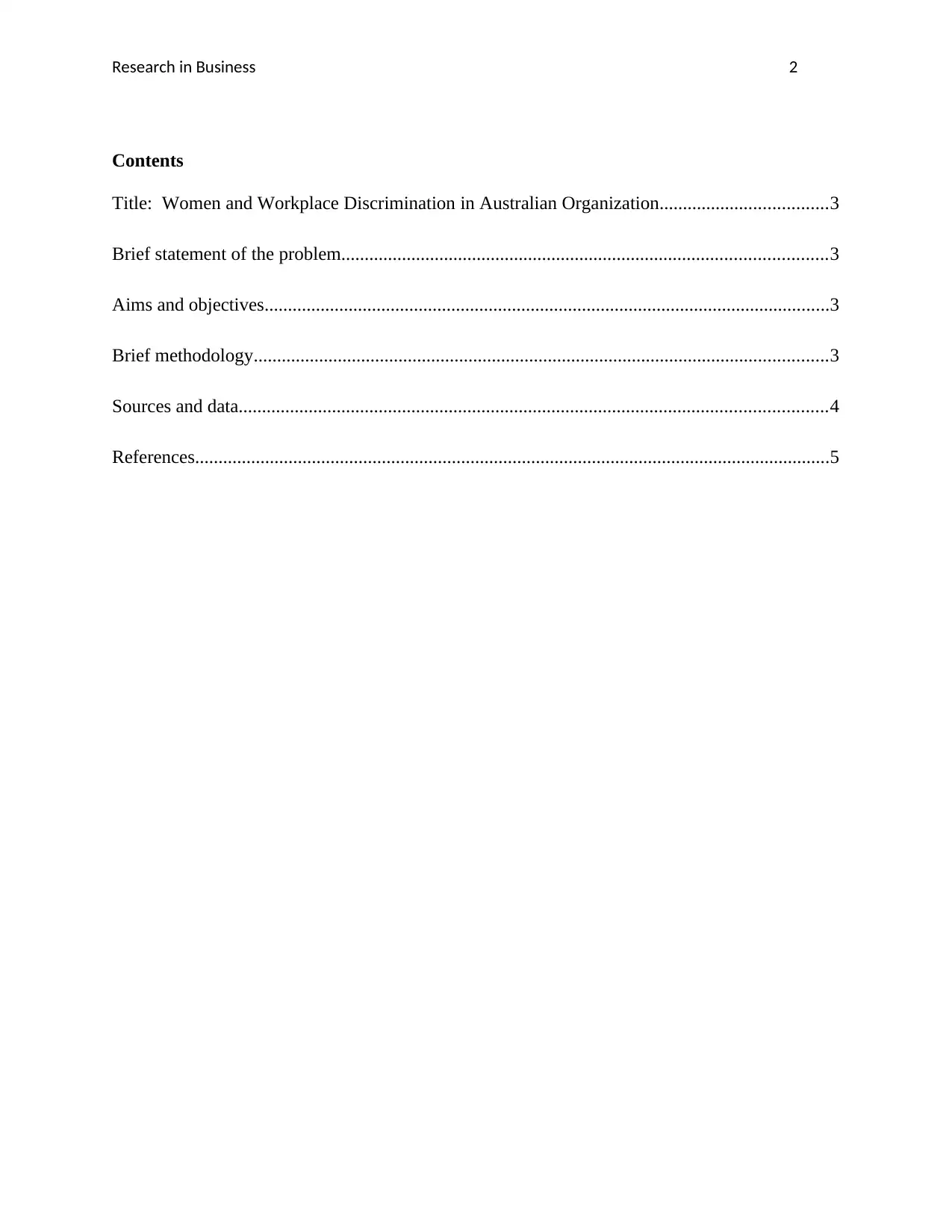
Research in Business 2
Contents
Title: Women and Workplace Discrimination in Australian Organization....................................3
Brief statement of the problem........................................................................................................3
Aims and objectives.........................................................................................................................3
Brief methodology...........................................................................................................................3
Sources and data..............................................................................................................................4
References........................................................................................................................................5
Contents
Title: Women and Workplace Discrimination in Australian Organization....................................3
Brief statement of the problem........................................................................................................3
Aims and objectives.........................................................................................................................3
Brief methodology...........................................................................................................................3
Sources and data..............................................................................................................................4
References........................................................................................................................................5
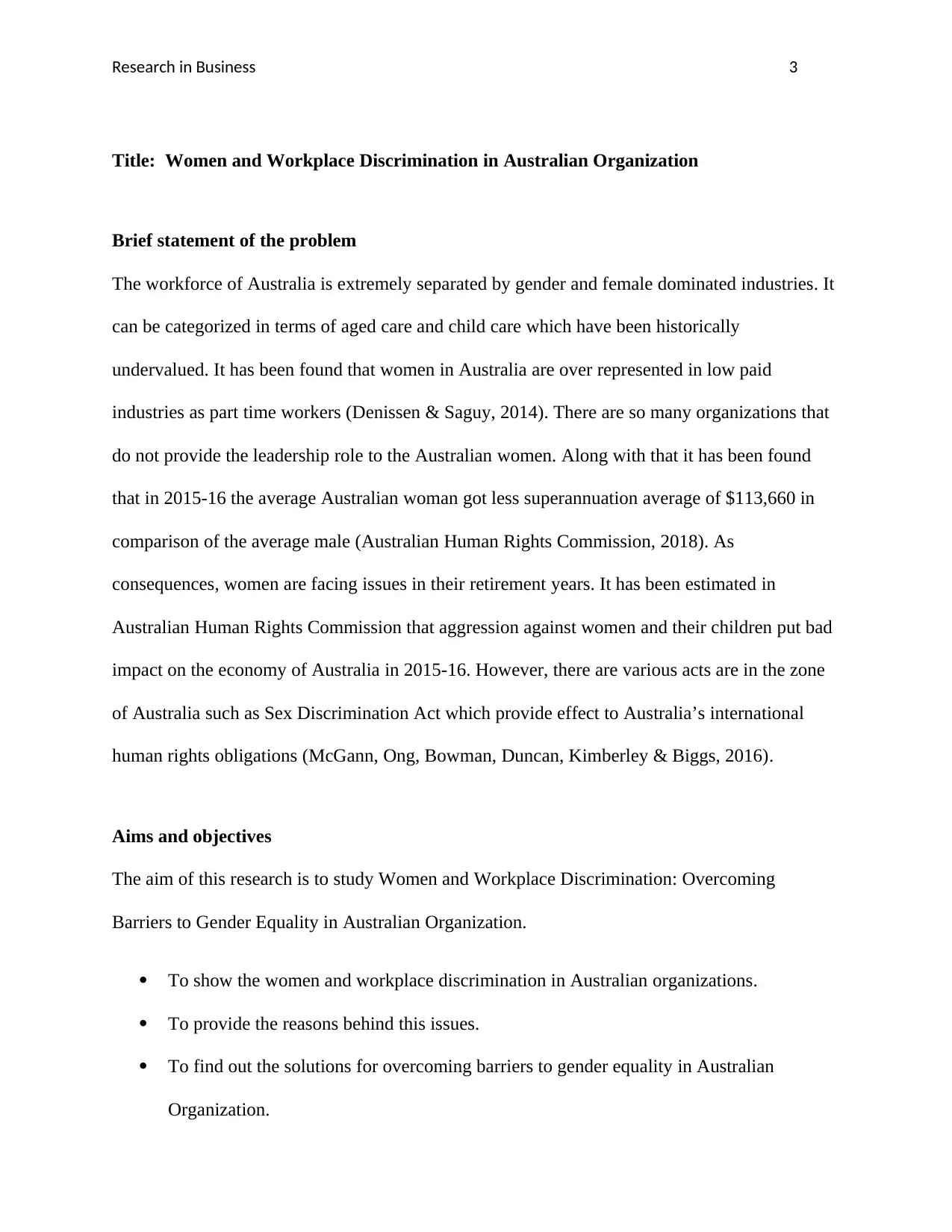
Research in Business 3
Title: Women and Workplace Discrimination in Australian Organization
Brief statement of the problem
The workforce of Australia is extremely separated by gender and female dominated industries. It
can be categorized in terms of aged care and child care which have been historically
undervalued. It has been found that women in Australia are over represented in low paid
industries as part time workers (Denissen & Saguy, 2014). There are so many organizations that
do not provide the leadership role to the Australian women. Along with that it has been found
that in 2015-16 the average Australian woman got less superannuation average of $113,660 in
comparison of the average male (Australian Human Rights Commission, 2018). As
consequences, women are facing issues in their retirement years. It has been estimated in
Australian Human Rights Commission that aggression against women and their children put bad
impact on the economy of Australia in 2015-16. However, there are various acts are in the zone
of Australia such as Sex Discrimination Act which provide effect to Australia’s international
human rights obligations (McGann, Ong, Bowman, Duncan, Kimberley & Biggs, 2016).
Aims and objectives
The aim of this research is to study Women and Workplace Discrimination: Overcoming
Barriers to Gender Equality in Australian Organization.
To show the women and workplace discrimination in Australian organizations.
To provide the reasons behind this issues.
To find out the solutions for overcoming barriers to gender equality in Australian
Organization.
Title: Women and Workplace Discrimination in Australian Organization
Brief statement of the problem
The workforce of Australia is extremely separated by gender and female dominated industries. It
can be categorized in terms of aged care and child care which have been historically
undervalued. It has been found that women in Australia are over represented in low paid
industries as part time workers (Denissen & Saguy, 2014). There are so many organizations that
do not provide the leadership role to the Australian women. Along with that it has been found
that in 2015-16 the average Australian woman got less superannuation average of $113,660 in
comparison of the average male (Australian Human Rights Commission, 2018). As
consequences, women are facing issues in their retirement years. It has been estimated in
Australian Human Rights Commission that aggression against women and their children put bad
impact on the economy of Australia in 2015-16. However, there are various acts are in the zone
of Australia such as Sex Discrimination Act which provide effect to Australia’s international
human rights obligations (McGann, Ong, Bowman, Duncan, Kimberley & Biggs, 2016).
Aims and objectives
The aim of this research is to study Women and Workplace Discrimination: Overcoming
Barriers to Gender Equality in Australian Organization.
To show the women and workplace discrimination in Australian organizations.
To provide the reasons behind this issues.
To find out the solutions for overcoming barriers to gender equality in Australian
Organization.
⊘ This is a preview!⊘
Do you want full access?
Subscribe today to unlock all pages.

Trusted by 1+ million students worldwide
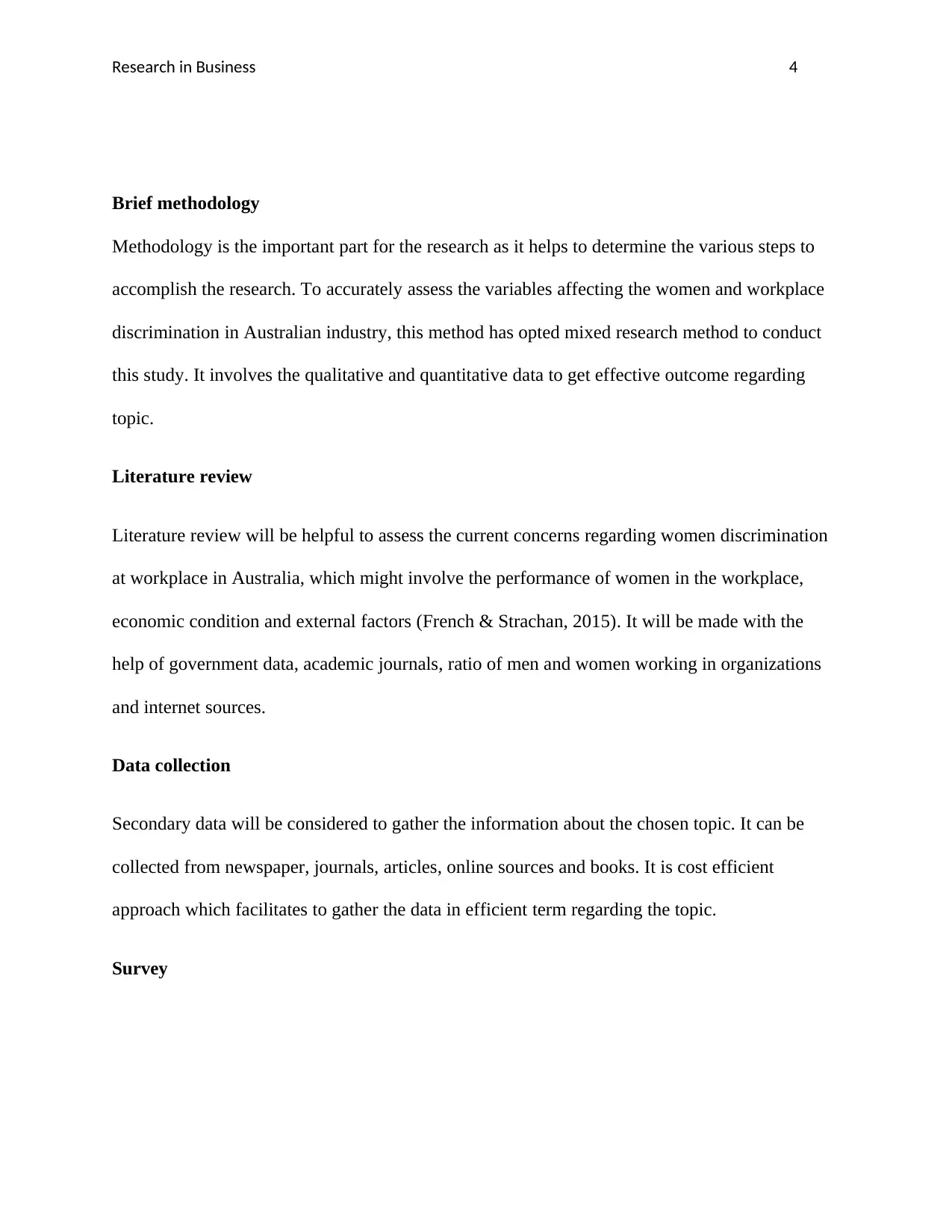
Research in Business 4
Brief methodology
Methodology is the important part for the research as it helps to determine the various steps to
accomplish the research. To accurately assess the variables affecting the women and workplace
discrimination in Australian industry, this method has opted mixed research method to conduct
this study. It involves the qualitative and quantitative data to get effective outcome regarding
topic.
Literature review
Literature review will be helpful to assess the current concerns regarding women discrimination
at workplace in Australia, which might involve the performance of women in the workplace,
economic condition and external factors (French & Strachan, 2015). It will be made with the
help of government data, academic journals, ratio of men and women working in organizations
and internet sources.
Data collection
Secondary data will be considered to gather the information about the chosen topic. It can be
collected from newspaper, journals, articles, online sources and books. It is cost efficient
approach which facilitates to gather the data in efficient term regarding the topic.
Survey
Brief methodology
Methodology is the important part for the research as it helps to determine the various steps to
accomplish the research. To accurately assess the variables affecting the women and workplace
discrimination in Australian industry, this method has opted mixed research method to conduct
this study. It involves the qualitative and quantitative data to get effective outcome regarding
topic.
Literature review
Literature review will be helpful to assess the current concerns regarding women discrimination
at workplace in Australia, which might involve the performance of women in the workplace,
economic condition and external factors (French & Strachan, 2015). It will be made with the
help of government data, academic journals, ratio of men and women working in organizations
and internet sources.
Data collection
Secondary data will be considered to gather the information about the chosen topic. It can be
collected from newspaper, journals, articles, online sources and books. It is cost efficient
approach which facilitates to gather the data in efficient term regarding the topic.
Survey
Paraphrase This Document
Need a fresh take? Get an instant paraphrase of this document with our AI Paraphraser
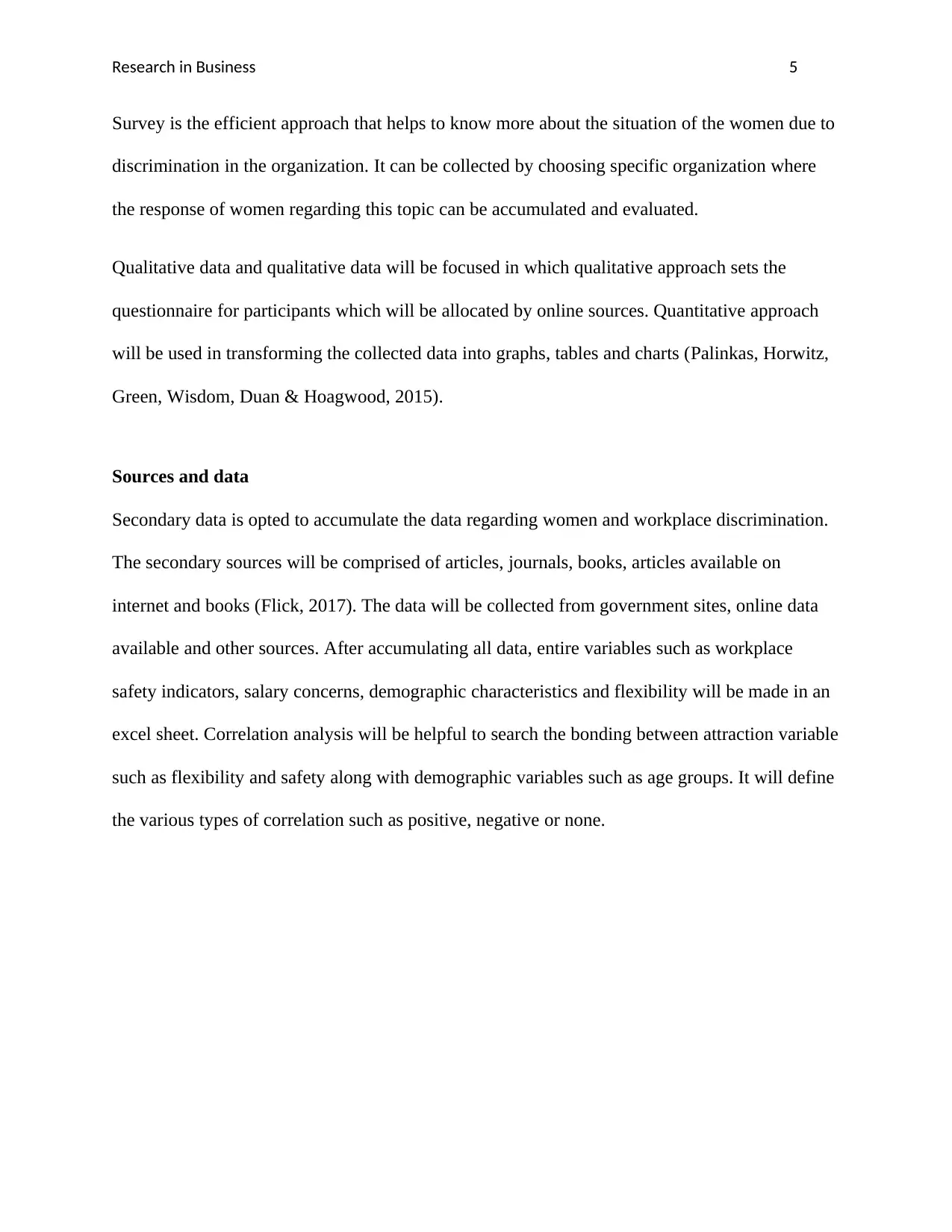
Research in Business 5
Survey is the efficient approach that helps to know more about the situation of the women due to
discrimination in the organization. It can be collected by choosing specific organization where
the response of women regarding this topic can be accumulated and evaluated.
Qualitative data and qualitative data will be focused in which qualitative approach sets the
questionnaire for participants which will be allocated by online sources. Quantitative approach
will be used in transforming the collected data into graphs, tables and charts (Palinkas, Horwitz,
Green, Wisdom, Duan & Hoagwood, 2015).
Sources and data
Secondary data is opted to accumulate the data regarding women and workplace discrimination.
The secondary sources will be comprised of articles, journals, books, articles available on
internet and books (Flick, 2017). The data will be collected from government sites, online data
available and other sources. After accumulating all data, entire variables such as workplace
safety indicators, salary concerns, demographic characteristics and flexibility will be made in an
excel sheet. Correlation analysis will be helpful to search the bonding between attraction variable
such as flexibility and safety along with demographic variables such as age groups. It will define
the various types of correlation such as positive, negative or none.
Survey is the efficient approach that helps to know more about the situation of the women due to
discrimination in the organization. It can be collected by choosing specific organization where
the response of women regarding this topic can be accumulated and evaluated.
Qualitative data and qualitative data will be focused in which qualitative approach sets the
questionnaire for participants which will be allocated by online sources. Quantitative approach
will be used in transforming the collected data into graphs, tables and charts (Palinkas, Horwitz,
Green, Wisdom, Duan & Hoagwood, 2015).
Sources and data
Secondary data is opted to accumulate the data regarding women and workplace discrimination.
The secondary sources will be comprised of articles, journals, books, articles available on
internet and books (Flick, 2017). The data will be collected from government sites, online data
available and other sources. After accumulating all data, entire variables such as workplace
safety indicators, salary concerns, demographic characteristics and flexibility will be made in an
excel sheet. Correlation analysis will be helpful to search the bonding between attraction variable
such as flexibility and safety along with demographic variables such as age groups. It will define
the various types of correlation such as positive, negative or none.
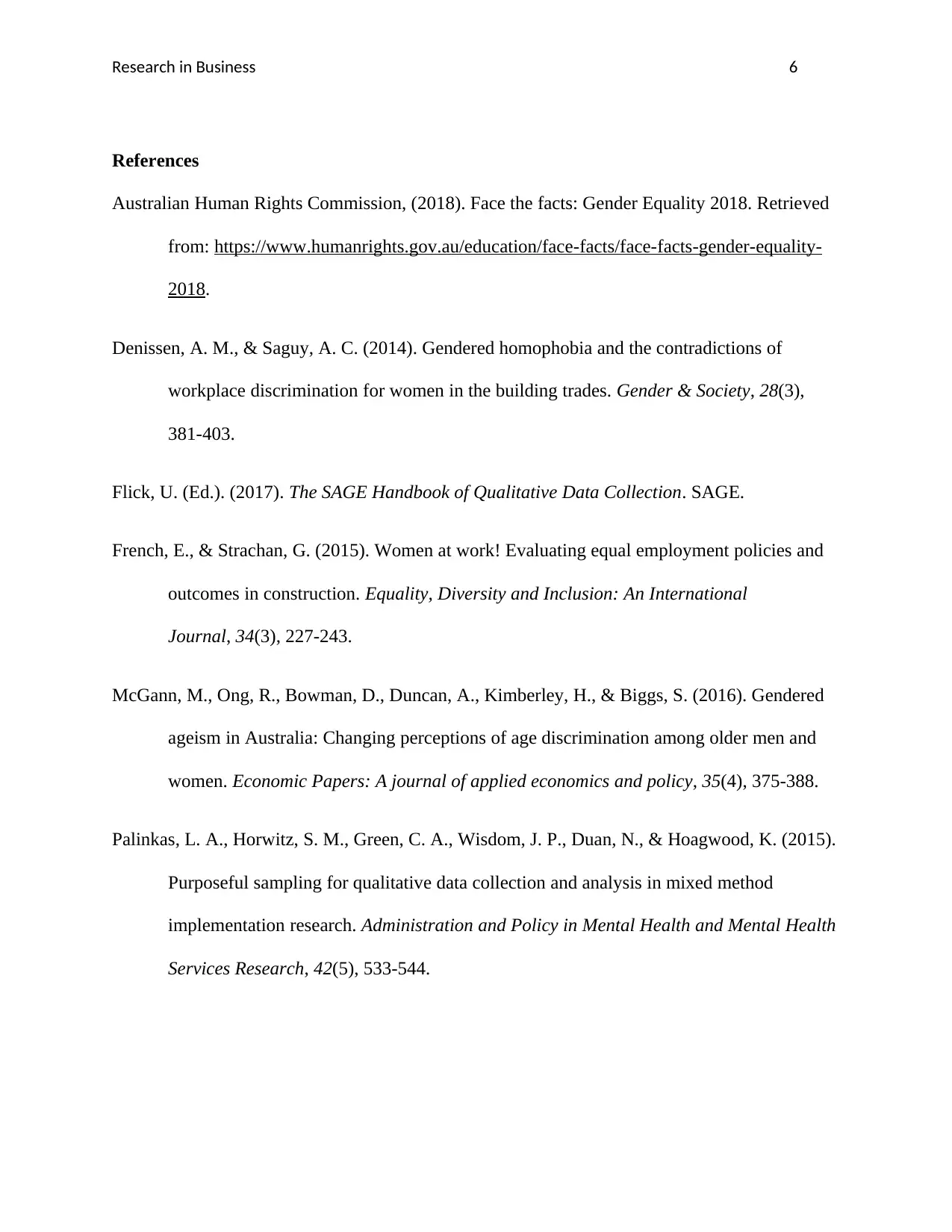
Research in Business 6
References
Australian Human Rights Commission, (2018). Face the facts: Gender Equality 2018. Retrieved
from: https://www.humanrights.gov.au/education/face-facts/face-facts-gender-equality-
2018.
Denissen, A. M., & Saguy, A. C. (2014). Gendered homophobia and the contradictions of
workplace discrimination for women in the building trades. Gender & Society, 28(3),
381-403.
Flick, U. (Ed.). (2017). The SAGE Handbook of Qualitative Data Collection. SAGE.
French, E., & Strachan, G. (2015). Women at work! Evaluating equal employment policies and
outcomes in construction. Equality, Diversity and Inclusion: An International
Journal, 34(3), 227-243.
McGann, M., Ong, R., Bowman, D., Duncan, A., Kimberley, H., & Biggs, S. (2016). Gendered
ageism in Australia: Changing perceptions of age discrimination among older men and
women. Economic Papers: A journal of applied economics and policy, 35(4), 375-388.
Palinkas, L. A., Horwitz, S. M., Green, C. A., Wisdom, J. P., Duan, N., & Hoagwood, K. (2015).
Purposeful sampling for qualitative data collection and analysis in mixed method
implementation research. Administration and Policy in Mental Health and Mental Health
Services Research, 42(5), 533-544.
References
Australian Human Rights Commission, (2018). Face the facts: Gender Equality 2018. Retrieved
from: https://www.humanrights.gov.au/education/face-facts/face-facts-gender-equality-
2018.
Denissen, A. M., & Saguy, A. C. (2014). Gendered homophobia and the contradictions of
workplace discrimination for women in the building trades. Gender & Society, 28(3),
381-403.
Flick, U. (Ed.). (2017). The SAGE Handbook of Qualitative Data Collection. SAGE.
French, E., & Strachan, G. (2015). Women at work! Evaluating equal employment policies and
outcomes in construction. Equality, Diversity and Inclusion: An International
Journal, 34(3), 227-243.
McGann, M., Ong, R., Bowman, D., Duncan, A., Kimberley, H., & Biggs, S. (2016). Gendered
ageism in Australia: Changing perceptions of age discrimination among older men and
women. Economic Papers: A journal of applied economics and policy, 35(4), 375-388.
Palinkas, L. A., Horwitz, S. M., Green, C. A., Wisdom, J. P., Duan, N., & Hoagwood, K. (2015).
Purposeful sampling for qualitative data collection and analysis in mixed method
implementation research. Administration and Policy in Mental Health and Mental Health
Services Research, 42(5), 533-544.
⊘ This is a preview!⊘
Do you want full access?
Subscribe today to unlock all pages.

Trusted by 1+ million students worldwide
1 out of 6
Related Documents
Your All-in-One AI-Powered Toolkit for Academic Success.
+13062052269
info@desklib.com
Available 24*7 on WhatsApp / Email
![[object Object]](/_next/static/media/star-bottom.7253800d.svg)
Unlock your academic potential
Copyright © 2020–2025 A2Z Services. All Rights Reserved. Developed and managed by ZUCOL.





